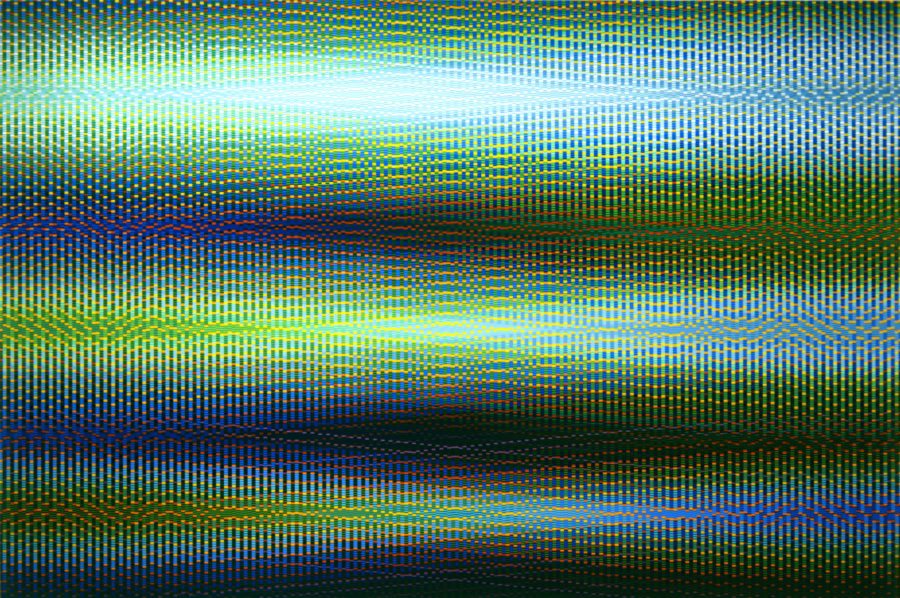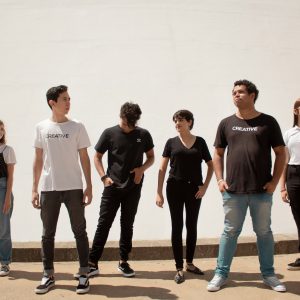 View Winners →
View Winners → Studio Visit – Eric Zammitt: October 2017

Recently, a friend recommended that I take a look at L.A. native Eric Zammitt’s stunning acrylic plastic wall works and luminescent floor sculptures, however, he is represented by galleries located in San Francisco and Santa Fe – too far for my weekend drive. Since he is based in LA, I reached out via his website and we set up a studio visit to see the work in person.
Eric’s studio is located in Altadena, near the base of the Angeles National Forest, Mt. Wilson Observatory and just a short drive beyond Pasadena. The studio is actually a labyrinth of interconnected rooms where Zammitt designs, lays out, assembles and finishes his pieces. Although the art is the star of the show, you can’t help being impressed by the workspace itself. All of the chambers are filled with his hand constructed tools and machinery used in the creation of the artworks.
Zammitt’s wall works and sculptures are constructed from tens of thousands of tiny colored acrylic plastic components, each perhaps 5mm – 6mm in size. The laborious creation process begins by taking giant sheets of colored acrylic and cutting them down to more manageable 6” x 6” squares. The colored wafers are then arranged and rearranged into from 2 to 5-foot towers until a pattern emerges that has the proper light, energy, balance, motion and sense of life in the artists mind. Eric’s process is somewhat experimental in nature; he doesn’t exactly know in the beginning what the resultant “painting” or sculpture will be, rather he lets it unfold organically over time. Next, the towers are glued together until hardened into monolithic vertical blocks.



Zammitt at work with custom tools and machinery in the workshop.
To construct the wall works, the towers are sliced into long slats, and again into sticks that can then be arranged into new designs. As you stare at the works, patterns start to emerge: Waves of light, a sense of energy and the DNA double helix are common elements in many of the wall pieces. Others seem to evoke feelings of music, time and digital pixilation even though they are analog (hand built) constructions. After watching his online video one sees how time-consuming and physically demanding the artist’s process is; it makes you wonder what drives one to expend so much effort to create these works. Eric’s father was also an artist that worked with plastics in the 1960s – perhaps something was passed down in the genes? The drive for creativity runs back yet another generation and seems to support the theory. His grandfathers were a Marvel cartoonist, and a precision “space race” machinist, respectively, and one of his grandmothers, a native Canadian Mohawk, a knitter of colorful patterned blankets.
Zammitt is also a master woodworker who teaches at the Art Center College of Design and could have easily been an engineer or scientist; it has to be something more. He spoke of the creative satisfaction that comes from solving technical problems precisely because they’re challenging. Given his choice of materials and their demanding physical properties these hurdles routinely present themselves. But the greatest satisfaction to solving them, Eric says, is getting to see the visual answers to his musings in the finished art itself. “That’s where the rubber really meets the road.”
After spending an hour in the studio and discussing art, process and his works I found a few pieces that kept pulling me back. My favorite has to be the nearly 8 foot tall “Triangular Twist”, a slowly spiraling tower, composed of green, yellow, and blue acrylic triangles separated by semi-transparent layers of colorless acrylic. The clear wedges allow the light to shine down and through the sculpture from differing angles, diffusing and bending the light in all directions like a prism. This is in contrast to the wall works that lack transparency and often reflect or mirror the light back toward the viewer. The sculptural works are very architectural in nature. The same lines can be seen in Moscow’s Evolution Tower or the Cayan Infinity Tower in Dubai. Where is LA’s Zammitt Tower on our skyline – Blade Runner 2079 perhaps?
 Another must have piece is Neptunium Halo – 44,486 pieces of circularly connected plastic that radiates power in all directions. From a distance is appears mostly in the blue /green spectrum and as you near the reds, oranges and yellows start to draw your attention – it looks like a futuristic genetic sequence projection. Historically, Zammitt’s work seems to sit comfortably between Color Field painting and the Light and Space movement. Many of his works have the ethereality and ambiguity of a Robert Irwin disc yet at the same moment, the palpable intensity of a vibrant Gene Davis painting. However, the work also exhibits a more modern version of pointillism to some extent. The patterns are extremely complex, yet the color balance and energy is always there. His sculptural work sits well among the minimalist and luminousity concerns of artists such as DeWain Valentine, Peter Alexander, and Craig Kaufman.
Another must have piece is Neptunium Halo – 44,486 pieces of circularly connected plastic that radiates power in all directions. From a distance is appears mostly in the blue /green spectrum and as you near the reds, oranges and yellows start to draw your attention – it looks like a futuristic genetic sequence projection. Historically, Zammitt’s work seems to sit comfortably between Color Field painting and the Light and Space movement. Many of his works have the ethereality and ambiguity of a Robert Irwin disc yet at the same moment, the palpable intensity of a vibrant Gene Davis painting. However, the work also exhibits a more modern version of pointillism to some extent. The patterns are extremely complex, yet the color balance and energy is always there. His sculptural work sits well among the minimalist and luminousity concerns of artists such as DeWain Valentine, Peter Alexander, and Craig Kaufman.

Neptunium Halo, 2016, 44,486 pieces of colored Plexiglas, 60” Diameter
If I were to pick one more piece for my collection it would be “Electric Moroccan Rain”, a whopping 92,396 pieces of colored acrylic glued into an amazing vertical landscape. The light bounces off the falling rain as the name suggests; the colors stream down the surface in a digitized waterfall of motion. The transition from light to dark increases the feeling of both movement and electricity. Many of the wall works create this feeling of vibration or physical energy levels (String Theory?), some have elements of musicality as well.

Moroccan Rain, 2009/20015, 91.5” x 49.5”, 92,396 pieces of colored Plexiglas
The “next generation” of quintessentially L.A. artists exploring the use of plastics and industrial materials, influenced by the light of the Pacific has to include Zammitt. He is a standout, and clearly the real L.A. deal. If you have an interest in Zammitt’s work and wish to arrange a studio visit please contact him via his website.











































































































